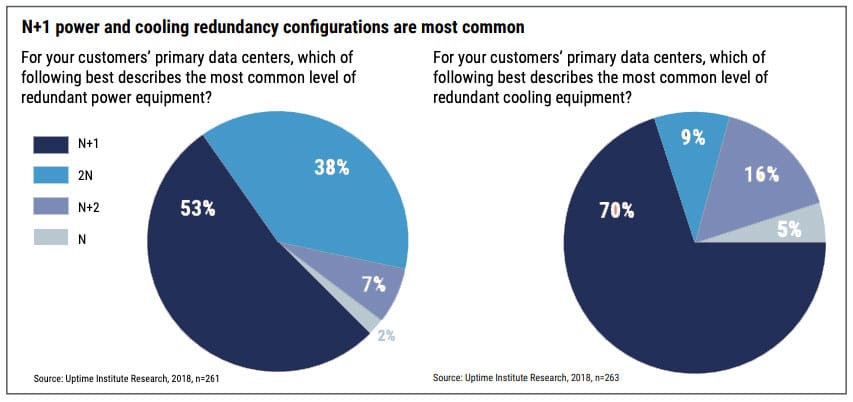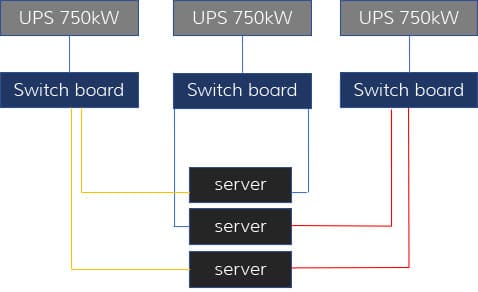Maintaining 100 percent uptime should be, and is top priority for every data center. But what is the difference between the various data center architectures? N+1, 2N, 2(N+1) or distributed redundancy, what is the difference and what impact does the architecture choice of your data center provider have?</p?
What does redundancy mean in Data Centers?
When a data center provider shares their facilities’ redundancy, they are referring to the amount of backup power available. If a utility failures occur due to severe weather, equipment failure or power line damage, data centers with more redundant power will be better equipped to avoid costly periods of downtime.
Most data centers have an architecture in place to cut the risk of downtime. There are different levels of redundancy which are often misunderstood or misrepresented. The purpose of this blog is to clarify the various definitions of data center architectures and highlight some of the misunderstandings often seen in data center evaluations.
What is N?
N equals the amount of capacity required to power or cool the data center facility at full IT load. A design of N means the facility was designed only to account for the facility at full load and zero redundancy has been added. If the facility is at full load and there is a component failure or required maintenance, mission critical applications would suffer. N is the same as non-redundant.
N+1 or N+X Data Center Architecture
If N equals the amount needed to run the data center facility N+1 provides minimal reliability by adding a component to support a single failure or requirement of that component. The simple way to look at N+1 is to think of it in term of ordering cakes for an office party. There are 25 people working in your office and you decide to order one more cake than needed (“just in case”). In this example “N” would represent the exact number of cakes you need (25), while the extra cake is the “+1”. You would be showing up to your office with N+1 or 26 cakes.
A data center example: if the total data center load is 1.000kW and each UPS platform can handle 500kW. In this case we need three UPS systems of 500kW (N=1.000kW, N+1=1.500kW). If one UPS is in maintenance mode we can ensure that the data center can deliver 1.000kW of UPS power. In this example we only name a single component, the UPS, but of course this model is also applicable for the generator and cooling infrastructure.
Design standards follow a rule of thumb of 1 added component for every 4 (max 5) needed. So, if for example (8) cooling units are required, a total of (10) would be accumulated for in a proper N+1 design.
2N or 2(N+1) Data Center Architecture
2N equates to fully redundant data center architecture, mirrored system, so if two UPS(s) are required there would be completely diverse and independent two UPS(s) for resiliency. In this design one can take down an entire leg with zero interruption to the critical IT load.
The redundant components do not need to be of the same make and model, or even of the same capacity, although redundant components with different capacities can increase the load management challenge. Common misrepresentation with 2N is a facility that is running at half load on an N or N+1 design. Just because a facility is currently at half the load designed does not make it 2N.
Back to our ‘cake’ example: If you need to order cakes for an office party, with 25 people you will order 50 cakes in 2 separate boxes. In this example “N” would represent the exact number of cakes you need (25), while the extra 25 cakes make the 2N. You would be showing up to your office with 2N or 50 cakes.
In above figure blue represent the “A” side and red represent the “B” side. Loads are redundantly and supported by both power feeds.
For the highest reliability, some data centers offer 2(N+1) architectures, which is actually the double amount capacity needed plus an extra capacity or a redundant N+1 system. This level of redundancy can tolerate multiple component failures or can maintain N+1 redundancy with an entire system down.
The downside of 2(N+1) architectures is the high price which needs to be paid. Besides the initial component costs, as well floor space and as well the high operation costs. For better reliability data centers choose for 2N solutions, which provides more flexibility and easier operational management.
Distributed Redundancy Data Center Architecture (3N/2 redundant)
The three-to-make-two or 3N/2 redundant configuration provides nearly 2N reliability with N+1 capital and operating costs, but with added load management challenges.
In below figure the server environment need 1.500kW of power, based on the distributed redundancy architecture. Each UPS can provide 750kW, if UPS C fails, the server environment will be provisioned with power.
A 4N/3 or 5N/4 architecture is technically possible but may be less reliable than a basic N architecture, simply because such an elaborate architecture has so many components that can fail and several load balancing points. A balanced architecture can tolerate only one failure without overloading the remaining components and an incorrectly load-balanced architecture may tolerate no failures.
Data Center Redundancy Benefits table
Summary table: benefits and shortcomings of various redundancy configurations, rated from 1-10, with 10 being the best. Reliability during maintenance assumes that a redundant component is down or that part or the entire system is bypassed.
Industry trend: N+1 Power and cooling redundancy is becoming more common
According to Uptime Institute’s operator survey 2018, N+1 architecture designs are becoming more popular, with 51% of operator respondents having N+1 cooling equipment and 41% having N+1 power equipment configurations.
A 2N design includes 100% replication of components/capacity, and so it would require a major failure of components to cause downtime. In a N+1 design a certain risk is taken on the available capacity because extra capacity/component (or sometime two extra components N+2) will cover for a single failure, or perhaps a limited amount more, but there may not be enough spare capacity to cover for a complete failure of the primary equipment. The use of N+1 is usually justifiable because the risk of multiple failures is so low.
N+1 data center architecture area becoming more popular for three reasons:
- N+1 data center architecture design is cheaper and more energy efficient because the physical infrastructure is lighter and uses less energy;
- Many colocation companies are under pressure from their (biggest) clients – cloud service providers – to build an N+1 data center infrastructure for costs reasons;
- N+1 data center architecture designs of a distributed resiliency plan may help organizations to meet operational requirements as well as better than traditional infrastructures.

The growth of N+1 architecture is an important trend with implications for data center / colocation providers. One finding from the Uptime Institute Operator Survey is that, of those with a 2N architecture, 22% had experienced an outage in last year, rising to 35% in the past three years (for all failures). But those with an N+1 architecture did not fare so well: 33% said they had an outage in the past year, rising to 51% in the past three years. The message is that the cheaper data center architecture (N+1) is currently less resilient – but that distributed resiliency plans based on N+1 architecture could prove equally as resilient as a 2N data center facility at lower costs.
For more information on Data Center Redundancy Architectures such as N+1, 2N, 2(N+1), Distributed Redundancy and the difference between them, as well as, the different Uptime Tier levels, contact our team (sales@datacenter.com) or call us at +31(0)20 2384200.




